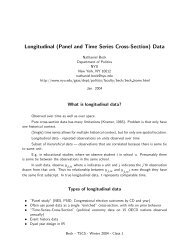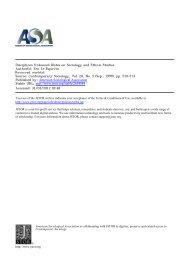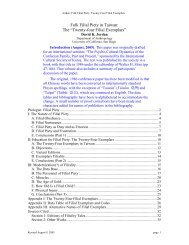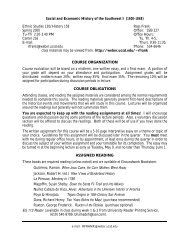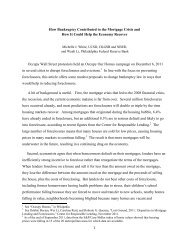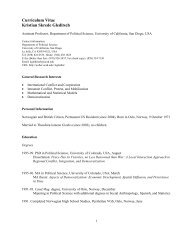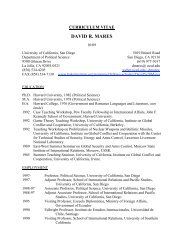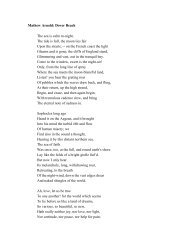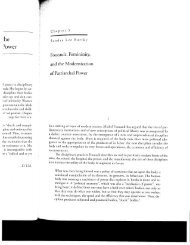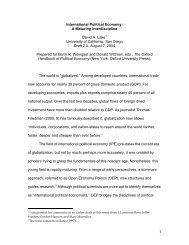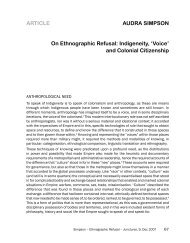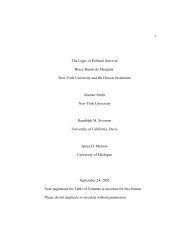Climate change and water resources in the Murray Darling Basin ...
Climate change and water resources in the Murray Darling Basin ...
Climate change and water resources in the Murray Darling Basin ...
You also want an ePaper? Increase the reach of your titles
YUMPU automatically turns print PDFs into web optimized ePapers that Google loves.
ABARE CONFERENCE PAPER 02.11<br />
<strong>Climate</strong> <strong>change</strong> <strong>in</strong> <strong>the</strong> <strong>Murray</strong> Darl<strong>in</strong>g Bas<strong>in</strong><br />
Regional projections of climate <strong>change</strong> <strong>in</strong> Australia under <strong>the</strong> scenarios have been<br />
conducted by CSIRO. These studies use regional climate models, on ei<strong>the</strong>r a 125 kilometre<br />
or 60 square kilometre grid that have been nested with<strong>in</strong> <strong>the</strong> CSIRO Mark II global<br />
climate model. Changes <strong>in</strong> average annual precipitation <strong>and</strong> potential evaporation are<br />
calculated us<strong>in</strong>g OZCLIM, a climate <strong>change</strong> scenario generator developed at CSIRO (Walsh<br />
et al. 2001). The impacts of global warm<strong>in</strong>g on average annual precipitation <strong>in</strong> <strong>the</strong> <strong>Murray</strong><br />
Darl<strong>in</strong>g Bas<strong>in</strong> for years 2050 <strong>and</strong> 2100 are shown for each scenario <strong>in</strong> maps 2 to 5. For<br />
<strong>the</strong> <strong>Murray</strong> Darl<strong>in</strong>g Bas<strong>in</strong>, <strong>the</strong> midrange of <strong>the</strong>se projections <strong>in</strong>dicates that <strong>the</strong>re will be a<br />
general decl<strong>in</strong>e <strong>in</strong> precipitation <strong>and</strong> an <strong>in</strong>crease <strong>in</strong> potential evaporation. However, <strong>the</strong><br />
extent <strong>and</strong> tim<strong>in</strong>g of <strong>the</strong> decl<strong>in</strong>e <strong>in</strong> <strong>the</strong>se parameters varies across <strong>the</strong> bas<strong>in</strong> <strong>in</strong> l<strong>in</strong>e with<br />
<strong>the</strong> differences between <strong>the</strong> global warm<strong>in</strong>g curves.<br />
In scenario SRES A1, <strong>the</strong> decl<strong>in</strong>e <strong>in</strong> precipitation is projected to be less than 5 per cent <strong>in</strong><br />
2050 for almost all catchments except <strong>in</strong> those feed<strong>in</strong>g <strong>the</strong> Victorian tributaries of <strong>the</strong><br />
<strong>Murray</strong> River where <strong>the</strong> decl<strong>in</strong>e is expected to be between 5 <strong>and</strong> 10 per cent. Projected<br />
decl<strong>in</strong>es <strong>in</strong> precipitation under <strong>the</strong> SRES B1 scenario are less severe. By 2100, precipitation<br />
decl<strong>in</strong>es by between 5 <strong>and</strong> 10 per cent for most of <strong>the</strong> bas<strong>in</strong> <strong>and</strong> by up to 20 per cent<br />
<strong>in</strong> <strong>the</strong> Victorian tributaries of <strong>the</strong> <strong>Murray</strong> River under <strong>the</strong> A1 scenario. In contrast, many of<br />
<strong>the</strong> <strong>Murray</strong> River tributaries are projected to experience a decl<strong>in</strong>e <strong>in</strong> precipitation of less<br />
than 10 per cent by 2100 under <strong>the</strong> SRES B1 scenario, <strong>and</strong> by less than 5 per cent <strong>in</strong> almost<br />
all of <strong>the</strong> Darl<strong>in</strong>g River tributaries.<br />
Ra<strong>in</strong>fall distribution is also likely to vary under climate <strong>change</strong>. Summer ra<strong>in</strong>fall is expected<br />
to decl<strong>in</strong>e under both scenarios, particularly <strong>in</strong> <strong>the</strong> sou<strong>the</strong>rn reaches of <strong>the</strong> bas<strong>in</strong>. Reductions<br />
<strong>in</strong> summer ra<strong>in</strong>fall for <strong>the</strong> Darl<strong>in</strong>g River tributaries are expected to be between 1 <strong>and</strong> 7<br />
per cent under <strong>the</strong> A1 scenario <strong>and</strong> between 2 <strong>and</strong> 6 per cent for <strong>the</strong> B1 scenario <strong>in</strong> 2100.<br />
Victorian tributaries of <strong>the</strong> <strong>Murray</strong> River are expected to experience a decl<strong>in</strong>e <strong>in</strong> summer<br />
ra<strong>in</strong>fall under both scenarios by 2100. While climate <strong>change</strong> projections based on <strong>the</strong><br />
SRES scenarios do not yield conclusive results on <strong>the</strong> frequency of La Niña <strong>and</strong> El Niño<br />
events, <strong>the</strong> severity of both flood <strong>and</strong> droughts is expected to <strong>in</strong>crease.<br />
In addition to precipitation, climate <strong>change</strong> has an impact on temperature, humidity <strong>and</strong><br />
w<strong>in</strong>d speed, all of which have an impact potential evaporation. An <strong>in</strong>crease <strong>in</strong> annual average<br />
potential evaporation is expected over <strong>the</strong> whole bas<strong>in</strong> under both global warm<strong>in</strong>g<br />
scenarios by 2100, particularly <strong>in</strong> <strong>the</strong> <strong>Murray</strong> River tributary catchments. The impacts are<br />
greater under <strong>the</strong> A1 scenario, with <strong>in</strong>creases <strong>in</strong> potential evaporation of almost 20 per<br />
cent <strong>in</strong> many of <strong>the</strong> sou<strong>the</strong>rn reaches. On balance, <strong>the</strong> projections for <strong>the</strong> <strong>Murray</strong> Darl<strong>in</strong>g<br />
Bas<strong>in</strong> are for slight to moderate reductions <strong>in</strong> <strong>water</strong> availability for dryl<strong>and</strong> agriculture<br />
<strong>and</strong> moderate to substantial reductions <strong>in</strong> surface <strong>water</strong> flows. Increases <strong>in</strong> open <strong>water</strong><br />
evaporation will also affect effluent stream systems, <strong>water</strong> storages <strong>and</strong> wetl<strong>and</strong>s.<br />
7




